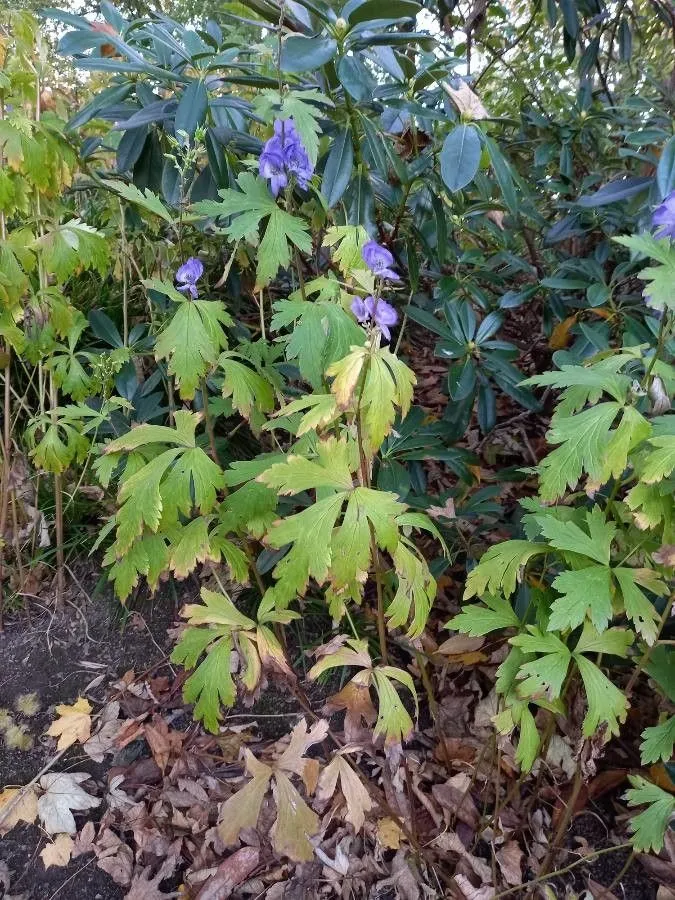
Author: L.
Bibliography: Sp. Pl.: 532 (1753)
Year: 1753
Status: accepted
Rank: species
Genus: Aconitum
Vegetable: False
Observations: C. & SE. Europe to C. Ukraine
Manchurian monkshood, scientifically known as Aconitum variegatum, is a perennial plant belonging to the Ranunculaceae family. This striking plant has a broad geographical presence, flourishing predominantly in Central and Southeastern Europe, extending its reach to Central Ukraine.
First detailed by the renowned botanist Carl Linnaeus in his seminal work “Species Plantarum” in 1753, Manchurian monkshood has been a subject of botanical interest for centuries. Linnaeus, often referred to simply as L., provided the foundational observations that have guided subsequent studies and classifications of this plant species.
Manchurian monkshood is renowned for its striking, often variegated flowers which may range from blue to purple hues, sometimes exhibiting a mix of colors. This variability is encapsulated in its scientific name, with “variegatum” alluding to its diverse and captivating flower coloration.
The plant is typically found in mountainous or hilly terrains where it thrives in temperate climates. It prefers moist, well-drained soils and partially shaded environments, making it a common sight in mountainous meadows, alongside streams, and in woodland clearings. Its blooming season spans late summer to early autumn, adding a splash of color to the landscape during these months.
Despite its beauty, Aconitum variegatum is infamous for its toxicity. Like other members of the Aconitum genus, it contains potent alkaloids that can be harmful if ingested or improperly handled. Awareness and caution are essential when dealing with this plant in both wild and cultivated settings.
Manchurian monkshood’s intriguing combination of allure and danger has made it a plant of fascination not only for botanists and horticulturalists but also for gardeners seeking unique and exotic additions to their gardens. However, its cultivation requires careful handling and respect for its potent properties.
Deu: bunter eisenhut
Eng: manchurian monkshood
Lit: margoji kurpaitė
Swe: brokig stormhatt
Fra: aconit panaché
En: Manchurian monkshood, European monkshood, Variegated Monk’s-hood
Ar: أكونيت موشم
Bg: Синя самакитка
Cs: Oměj pestrý
Fi: Tarhaukonhattu
Fr: Aconit panaché, Aconit à bec
De: Bunter Eisenhut, Gescheckter Eisenhut, Geschnäbelter Eisenhut
Hu: Karcsú sisakvirág
Is: Snoðhjálmur
It: Aconito screziato, Aconito rostrato
Li: Bóntje paterskap
Lt: Margoji kurpaitė
Pl: Tojad dzióbaty
Ru: Борец пёстрый
Es: Pisana preobjeda
Sv: Brokig stormhatt, Trädgårdsstormhatt
Uk: Тоя строката
© copyright of the Board of Trustees of the Royal Botanic Gardens, Kew.
Taken Aug 17, 2022 by Oldneo (cc-by-sa)
Taken Sep 20, 2021 by walter markus (cc-by-sa)
Taken Oct 18, 2020 by Paz Sebastián (cc-by-sa)
Taken Nov 28, 2021 by Krampl Tomáš (cc-by-sa)
Taken Sep 6, 2021 by Paolo Adamoli (cc-by-sa)
Taken Aug 18, 2021 by Marie Skalická (cc-by-sa)
Taken May 13, 2021 by g a (cc-by-sa)
Taken Aug 17, 2022 by Oldneo (cc-by-sa)
Taken Aug 8, 2022 by Henri Sneessens (cc-by-sa)
Taken Nov 28, 2021 by Krampl Tomáš (cc-by-sa)
Taken Jul 27, 2018 by Tela Botanica − Michel Pansiot (cc-by-sa)
Taken Jul 15, 2018 by Photoflora – Benoit BOCK (©)
Taken Aug 15, 2011 by Photoflora – Bernard TILLY (©)
Taken Jul 27, 2018 by Tela Botanica − Michel Pansiot (cc-by-sa)
Taken Nov 6, 2021 by Kai Best (cc-by-sa)
Taken Aug 9, 2022 by Anatas (cc-by-sa)
Taken Aug 9, 2022 by Anatas (cc-by-sa)
Taken Aug 9, 2022 by Anatas (cc-by-sa)
Taken Aug 24, 2016 by Miguel Borruel (cc-by-sa)
Taken Aug 15, 2003 by Photoflora – Jean-Luc TASSET (©)
Taken Aug 15, 2017 by Photoflora – Jean-Luc TASSET (©)
Taken Jan 1, 1970 by Photoflora – L’Abbé COSTE (©)
Growth habit: Forb/herb
Ph maximum: 7.5
Ph minimum: 7.0
Light: 7
Atmospheric humidity: 8
Bloom months: [‘jul’, ‘aug’]
Soil nutriments: 7
Family: Myrtaceae Author: (F.Muell.) K.D.Hill & L.A.S.Johnson Bibliography: Telopea 6: 402 (1995) Year: 1995 Status:…
Family: Rubiaceae Author: Pierre ex A.Froehner Bibliography: Notizbl. Bot. Gart. Berlin-Dahlem 1: 237 (1897) Year:…
Family: Sapindaceae Author: Koidz. Bibliography: J. Coll. Sci. Imp. Univ. Tokyo 32(1): 38 (1911) Year:…
Family: Asteraceae Author: A.Gray Bibliography: Pacif. Railr. Rep.: 107 (1857) Year: 1857 Status: accepted Rank:…
Family: Fabaceae Author: Medik. Bibliography: Vorles. Churpfälz. Phys.-Ökon. Ges. 2: 398 (1787) Year: 1787 Status:…
Family: Aspleniaceae Author: (Cav.) Alston Bibliography: Bull. Misc. Inform. Kew 1932: 309 (1932) Year: 1932…